Ever since I got my hands on my first guitar, over four decades back, there’s something that has continuously evoked intrigue – the Epiphone G-1275, an iconic double neck instrument with a distinct sound and aesthetics.
This isn’t just another guitar in the world of fretboards and strings; it’s a potent statement of style and craft, a masterpiece that transcends conventional attributes of regular six-stringed brethren. This captivating appeal, coupled with a passionate interest for unique Epiphone electric guitars, led me on a journey to know this masterpiece inside out.
After thousands of hours strumming those strings, understanding its soulful cries, and analyzing expert opinions, I realized that an in-depth, practical guide on this legend was glaringly missing.
So, here I am, with decades of guitar experience and knowledge, penning an exclusive and detailed review of the Epiphone Double Neck Guitar. As we delve into this guide, we will explore it’s heritage, unique features, how it compares with other iconic guitars and much more.
But first, let’s set the stage with an unusual claim that might raise a few eyebrows: No guitar, in my extensive experience, resonates with the palpable mix of awe and challenge quite like an Epiphone G-1275 double neck guitar.
Hard to grasp? Intrigued? Stick with me as I unravel why I stand by this bold statement, taking you through the ins and outs of this timeless legend, in the mesmerizing world of music.
Epiphone Double Neck Guitar Overview
Comparison with Notable Models
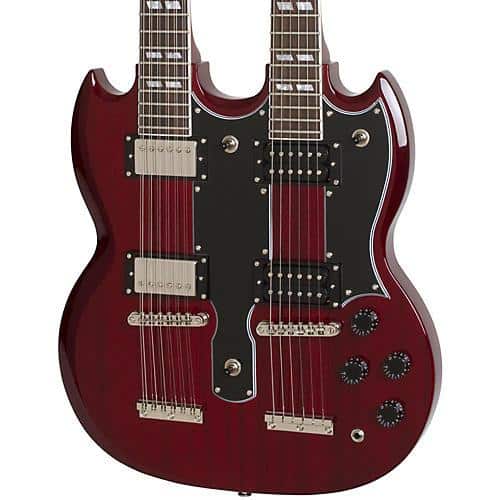
Having played numerous Gibson models and owning an Epiphone myself, the comparison between these esteemed models paints a vibrant picture of the Epiphone Double Neck Guitar. The Epiphone brand shares much with its parent company Gibson, evidenced in the notable model, the Gibson EDS-1275 doubleneck. The design ethos is carried forward, providing a look and feel reminiscent of the legendary Jimmy Page double neck guitar.
The stand-out feature of the Epiphone Double Neck is its versatility, popular with artists spanning diverse genres. The resemblance to its pageantry cousin, the Gibson EDS-1275, is striking. Yet while Gibson demands a significant premium, the Epiphone’s sensible pricing broadens its appeal.
Unmistakably, the Gibson Les Paul sets a high bar. Its punchy tones, superior sustain and exemplary finish serve as the industry’s gold standards. However, the Epiphone, while not directly comparable, nails the perfect balance. It may not provide the exact same elite prestige as a Gibson, but it does manage to encapsulate a considerable part of that essence in a more affordable package. The versatility of switching between 6-string and 12-string configurations is a hallmark of the Epiphone, adding an extra layer of functionality that the Les Paul series does not have.
In conclusion, the Epiphone Double Neck Guitar draws a lot from its Gibson lineage. However, it also carves its own path by appealing to a set of users that value flexibility, affordability, and classic, retainable sound. As we traverse into celebrity ownership, user experiences, and technical details, remember this comparison as a testament to Epiphone’s status as a respected guitar brand.
Celebrity Ownership
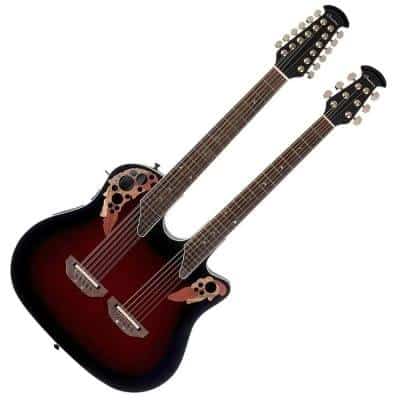
In my professional journey, I’ve shared both the exhilaration and anxiety of live performances with multiple exceptional guitarists. Many of them vouch for the Epiphone double neck guitar as their go-to instrument for its versatility and sound brilliance. Most notably, Frank Hannon of Tesla. Hannon’s powerful riffs and magnificent solos are amplified by the unique tones and capabilities of his double neck Epiphone. However, it’s not just about the flair; his testimony emphasizes the instrument’s user-friendliness and unparalleled sound quality.
These celebrity-owned guitars aren’t mere pieces of flashy equipment; they play a significant part in shaping the music and creating impactful moments during concerts. An Epiphone double neck guitar stands as a testament of quality, catching the eye, and the ear, of both the listeners and fellow musicians.
Moving forward, understanding the technical specifications of this guitar will help us better appreciate why it is a favorite of musicians like Frank Hannon. From layout to electronics, let’s delve into what gives the Epiphone double neck its distinguished reputation.
Technical Specifications
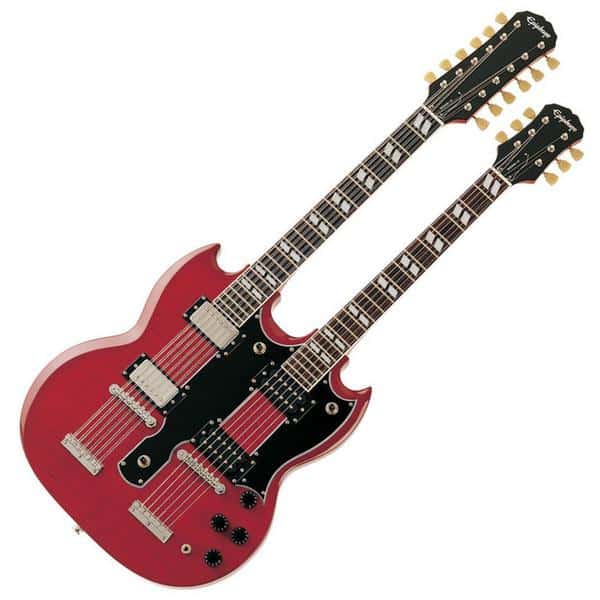
As we delve deeper into the world of the Epiphone G-1275 double neck guitar, it becomes evident that its enigmatic appeal stems from a well-planned intriguing blend of top-notch materials, designed aptly for sound clarity and aesthetics. Drawing on my experience as a seasoned musician and guitar enthusiast, I’ll take you on a comprehensive exploration of this remarkable instrument’s technical specifications, shedding light on the magic ingredients that contribute to its enduring appeal. So, what are these ingredients? Let’s slice deep into the G-1275’s heart!
Essentially, the heart of the G-1275’s classic allure lies in its generous use of mahogany in its design. This significantly contributes to the guitar’s distinctive electric guitar tone. As a matter of fact, the mahogany body on this Epiphone double neck guitar works splendidly to produce an appealing warm tone characterized by a robust mid-range.
It is, however, the enchanting contrast between the Alpine White finish and the deep-rich Cherry finish that gives the G-1275 its characteristic aesthetic appeal. The Alpine White finish, particularly used on the body and neck, adds an element of tasteful sophistication, while the Cherry finish on the back and sides emanates a fiery, vintage appeal. This combination makes the G-1275 a feast for the eyes, as well as the ears!
As much as the signature finishes contribute to its classic look, the dual SlimTaper D-profile necks with their rosewood fingerboards play an equally critical part in the overall design. Ensuring optimal playability, these necks offer comfortable hold and movement, allowing guitarists to access higher frets with ease. It’s remarkable how this ingenious combination of design allows for such effortless playability, even on a uniquely shaped double neck guitar.
Moreover, the rosewood fingerboards add a touch of luxury and enhance the G-1275’s sonic character. They provide a smooth playing surface while also absorbing any sharp overtones. The result is a balanced tone that maintains the warm character of the mahogany body without muddying the sound.
Adding to the overall aesthetics and carrying a bit of vintage charm, the addition of pearloid parallelogram inlays on the fingerboards gives the G-1275 an elegant and distinctive visual appeal. It’s all these meticulously chosen elements that make the G-1275 the beloved classic that it continues to be.
Owning an Epiphone G-1275 is indeed like owning a piece of music history, a classic guitar that hasn’t lost its charm even after decades. We have now dived into the intricate details and craftsmanship behind this enduring classic. It is clear that the G-1275’s appeal lies in more than just its unique dual neck design; it is the beautiful blend of quality materials, aesthetic appeal, and distinct tonal character that make it truly special.
As we move forward, let me share with you the experiences of other musicians, their reviews, and insights on this iconic double neck guitar – to lend a broader perspective and reaffirm why the G-1275 continues to capture the admiration of guitar enthusiasts worldwide
.
User Experiences and Reviews
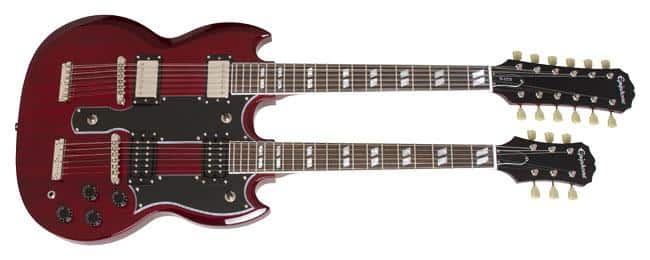
Throughout my journey in founding Peghead Nation—an e-learning site dedicated to stringed instruments—I’ve unearthed countless user reviews and experiences with guitars of all makes and models. Yet, few have sparked such an interesting mix of opinions as the Epiphone double neck guitar. It’s captivating in its complexity, and challenging in its versatility. As someone who deeply respects the fine artistry that goes into making such an instrument, I feel both privileged and excited to delve into this pool of information.
Anyone can share a personal opinion, but what are the collective thoughts and experiences of guitarists worldwide on the Epiphone double neck guitar? Having trawled through numerous music instrument forums and poured over a plethora of reviews, I’ve found a consensus that denotes this guitar as an attention-grabbing spectacle that couples impressive craftsmanship with dynamic playability.
The Epiphone double neck, particularly the limited edition guitars within that range, often elicit tales of awe and astonishment. Users depict memorable experiences of unpacking their new guitar and first laying eyes on the double neck’s intricate details—each string, knob, and fret perfectly placed. There’s a unanimously shared admiration for the Epiphone’s ability to marry aesthetics with functionality in this beast of a guitar.
However, sentiment isn’t always about grandeur. A common thread in many reviews speaks to the accessibility of this complex instrument—even for aspiring guitarists. The Epiphone double neck’s design allows for seamless transitions between the 6 and 12-string necks, allowing musicians to experiment and expand their sound palette without the need for multiple instruments.
On the journey delving into the world of guitars, there’s a deep-seated reverence for vintage guitar models. Interestingly, while the Epiphone double neck might not carry decades of history in its crafting, its unique design and superb quality place it among such rarities, hinting at a promising legacy of its own. Several reviews indicate that this guitar, despite its novelty, could hold its ground even among seasoned musicians and vintage guitar enthusiasts.
As with any product, the guitar isn’t without constructive criticism. Some users found it to be slightly on the heavier side, while others grappled with adjusting to the unconventional spacing between the two necks. But, these aspects didn’t dramatically diminish the overall positive sentiment towards the Epiphone double neck guitar—a testament to its appeal.
All these user experiences and reviews form a fascinating, multifaceted narrative around this unique piece of musical craft. Yes, it’s precisely the kind of in-depth feedback potential buyers will find valuable. However, it’s also an intricate glimpse into the dynamic relationship between musicians and their instruments. The Epiphone double neck guitar is not just a means to produce music—it’s an experience, a story, and an adventure.
So, as we delve deeper into the nuances of this extraordinary instrument, remember the wealth of collective experiences and insights we’ve shared. It truly shapes our understanding and appreciation of it in the broader context of guitar craftsmanship.
Tips for Maintenance and Potential Upgrades
Choosing the Right Guitar Stand
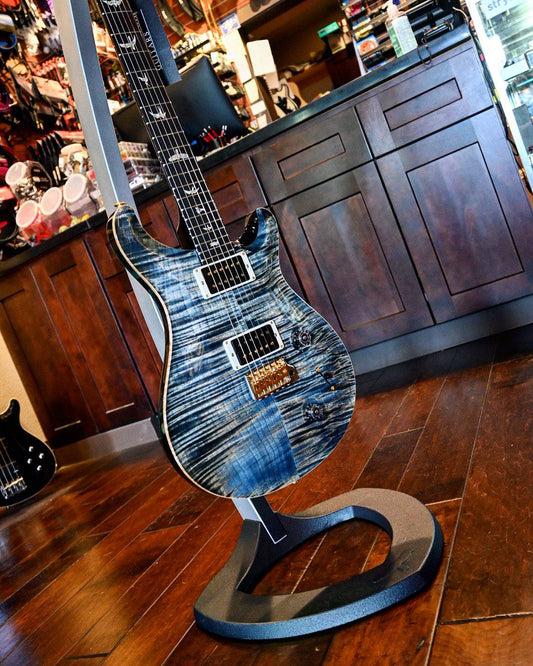
Moving on from general maintenance and potential upgrades, one area that I’ve often found to be sidelined is the importance of choosing the right guitar stands for double neck guitars. Having experienced the struggle firsthand, I can’t emphasize enough the difference the right stand can make. It’s not just about storage; it safeguards your instrument and makes routine maintenance easier.
The weight and balance of a double neck guitar make it a challenge to store properly. An unsteady stand risks damaging the guitar. Therefore, you need a stand designed specifically for double neck guitars. While such specialized stands may be a bit pricier, they ensure your guitar’s safety and longevity.
Selecting a stand with adjustable neck cradles is a must. This feature accommodates the unique shape and size of a double neck guitar, providing the much-needed balance. A stand with a secure lock is crucial too, preventing accidental knock-overs.
Remember, a durable, stable, and specific stand goes a long way in protecting your prized Epiphone Double Neck Guitar. As an investment, it plays an integral role in your guitar’s upkeep and longevity. In the following section, we’ll explore some other frequently asked questions to help enhance your double neck guitar experience.
FAQs
What is an Epiphone Double Neck Guitar?
Why choose the Epiphone Double Neck Guitar?
How much does an Epiphone Double Neck Guitar cost?
Can I customise my Epiphone Double Neck Guitar?
Conclusion
Reflecting on this comprehensive journey through the world of Epiphone electric guitars, particularly the G-1275 model, one can’t help but realize how deeply invested the brand is in enhancing the music experience. After all, does owning an Epiphone double neck guitar mean owning a part of music history? My experiences, both personal and professional, attest to the fact that it does. I am of firm belief that guitars like the G-1275, with its unique features and stellar performance, qualify as iconic guitars in the world of music.
Remember, this thematic guide is a result of my years-long journey with Epiphone. As a music aficionado and a seasoned guitarist, I consider the Epiphone G-1275 as an indispensable addition to my collection. This instrument, with its signature double neck design and powerful projection, personifies innovation and quality craftsmanship.
Deciphering the various aspects of the G-1275, from its famed celebrity ownership to its technical specifications, has been an enlightening journey. Feedback from the user experiences section emphasized the G-1275’s standing among guitar enthusiasts. Meanwhile, exploring the necessary tips for maintenance and potential upgrades offered an insightful standpoint for seasoned artists and budding guitarists alike.
It is crucial to consider that a guitar stand can tremendously impact the longevity of your instrument, and choosing wisely becomes all the more vital. The FAQs section represented a myriad of commonly queried elements, further adding to the comprehensive perspective.
In conclusion, the Epiphone G-1275 is more than just an instrument; it’s a testament to Epiphone’s commitment to revolutionize the world of music. And boldly asserting its iconic status, the Epiphone double neck guitar indeed let us own a slice of music history.